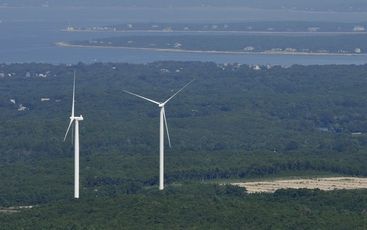
****
A Court in Falmouth, Massachusetts has just pulled a halt to the operation of a couple of giant fans that have been driving townspeople nuts since they kicked into gear 3½ years ago.
The action launched by locals is based on the tort of nuisance – one of the oldest around (as to which, see our little law primer after the story below).
The Court decided to grant an injunction shutting the turbines down overnight, prior to determination of the substantive case. A Court has a discretion to pull to a halt any wrongful activity before it hears all the evidence in a full-blown trial aimed at working out whether the injunction granted should be made permanent.
In the Falmouth case, the Judge decided that there was more than enough evidence of “irreparable harm” to warrant an injunction before the issues in dispute could be fully tried. Here’s the story as told by The Republic.
Judge orders limited use of Falmouth wind turbines after neighbors complain of health issues
The Republic
22 November 2013
BARNSTABLE, Massachusetts — The town of Falmouth was ordered by a judge on Friday to limit the hours two town-owned wind turbines operate after neighbors blamed them for a series of health problems.
Effective immediately, the energy-generating turbines at the Cape Cod town’s wastewater treatment facility are only allowed to operate from 7 a.m. until 7 p.m. on every day of the week except Sunday, and are not allowed to operate at all on Thanksgiving Day, Christmas Day and New Year’s Day, Superior Court Judge Christopher Muse wrote in the decision.
Neil and Elizabeth Andersen, who live about a quarter of a mile from the turbines, said they caused “continuous insomnia, headaches, psychological disturbances, dental injuries, and other forms of malaise” they had not suffered prior to the turbines’ construction.
“The court finds the Andersens claims that they did not experience such symptoms prior to the construction and operation of the turbines, and that that each day of operation produces further injury, to be credible,” the judge wrote.
Continued operation of the turbines at previous levels put residents at risk of “irreparable physical and psychological harm,” he judge wrote.
The environmental group Wind Wise Massachusetts called it a landmark decision.
“This is believed to be the first time that a court in the U.S. has ruled that there is sufficient evidence that wind turbines near residential areas are a health hazard to families living nearby,” said Virginia Irvine, president of Wind Wise Massachusetts.
The decision has repercussions in other Massachusetts towns where wind turbines are being blamed for health problems, Neil Andersen said.
“It’s torture,” he said of the turbines’ noise and pressure effects. “But this decision is a victory. It gives us some relief.”
The 1.65 megawatt turbines were erected about 3½ years ago to power the treatment plant and to create revenue for the town by selling electricity back to the grid.
They ran 24/7 at first, but more recently have been running from 5 a.m. until 9 p.m. daily, he said.
Each turbine is almost 400 feet tall from the ground to the tip of the blade at its highest point.
They have been the subject of disagreements and lawsuits between town boards and townwide votes on whether to dismantle them entirely.
The town argued against restricting the hours of operation, saying shorter hours would reduce revenue from sales of energy back to the grid. The judge rejected that argument.
The town’s lawyer was not immediately available to comment on the judge’s decision.
The judge told the sides to work on a mitigation plan and submit it to the court in 75 days.
The Republic
You can read the decision granting the injunction here.
STT’s Nuisance “In-a-Nutshell”
Nuisance is a long recognised tort (civil wrong) at common law based on the wrongful interference with a landowner’s rights to the reasonable use and enjoyment of their land.
Negligence is not an element of nuisance, although aspects of the former may overlap with the latter. Where, as here, the conduct is intentional (ie the operation of the wind turbines is a deliberate act) liability is strict and will not be avoided by the defendant showing that it has taken all reasonable steps to avoid the nuisance created. Indeed, the conduct of the defendant is largely irrelevant (unless malice is alleged); the emphasis is on the defendant’s invasion of the neighbouring landowner’s interests.
A defendant will have committed the tort of nuisance when they are held to be responsible for an act indirectly causing physical injury to land or substantially interfering with the use or enjoyment of land or of an interest in land, where, in the light of all the surrounding circumstances, this injury or interference is held to be unreasonable.
The usual remedy for nuisance is an injunction restraining the defendant from the further creation or continuance of the nuisance. Injunctions are discretionary, in all cases, and will not be granted unless the nuisance caused is significant.
Where interference with the enjoyment of land is alleged, the interference must be “substantial” and not trivial.
Interference from noise will be substantial, even if only temporary in duration, if it causes any interference with the plaintiff’s sleep.
The loss of even one night’s sleep through excessive noise has been repeatedly held to be substantial and not trivial in this sense (see Andreae v Selfridge & Co [1937] 3 All ER 255 at 261, quoted with approval in Munro v Dairies Ltd [1955] VLR 332 at 335; Kidman v Page [1959] St R Qd 53 at 59; see also Halsey v Esso Petroleum Co Ltd [1961] 1 WLR 683 at 701: “a man is entitled to sleep during the night in his own house”).
It is not a defence for the party creating the nuisance to claim that he is merely making a reasonable use of his property. The defendant’s conduct may well be otherwise lawful, but still constitute actionable nuisance. The activity engaged in by the defendant may be of great social utility or benefit, but that has been repeatedly held as being “insufficient to justify what otherwise would be a nuisance” (see For example, Munro v Dairies Ltd [1955] VLR 332 at 335; see also Halsey v Esso Petroleum Co Ltd [1961] 1 WLR 683)
Halsey’s case is well worth a read – a real “David and Goliath” battle, as described by the trial Judge: “This is a case, if ever there was one, of the little man asking for the protection of the law against the activities of a large and powerful neighbour.” And just like David’s epic battle with a thuggish giant, the little bloke won!
Here’s a link to the case: Halsey v Esso Petroleum [1961] 1 WLR 683


WIND-WATCH.ORG!!!!!!!!!!!!!!!!!!!!!!!!!!!!!!!!!!!!!!!!!
We all know the truth will come out, and it is. THANKS STT -the fruits of your and other good peoples work is coming forth. It is only a matter of time when that court rooms will be a hive of activity shutting down industrial wind turbines. And not before time.
Hooray! At last, that light at the end of the tunnel looks more and more like the head lamp of an on coming train and the wind weasels are stuck in the tunnel!
The light at the end of our tunnel looks like the light of reason and truth finally starting to shine through.
Thank you STT for continuing to share your legal, economic, technical and political teams’ wisdom and insights. Always informative and educational.
The wind industry’s strategies of deceit and misinformation are failing. They can no longer rely on the Green lies of ‘no evidence of adverse impacts’ and ‘carbon free power’.
The game is up. The tide is turning. The Truth is finding some clear air. At last!
The green lies and malicious tactics are being exposed in the courts. They are now being held accountable for for their dishonest words and actions via the justice system, because it is clear that corrupted or lame politicians (especially the limp Greens) and Government regulatory authorities the world over have failed to adequately protect their citizens.
And three cheers for the residents of Falmouth!
Now that’s a result – they are not going to be able to ‘hide’ anymore, the end is coming and this will be a huge nail in the coffin.